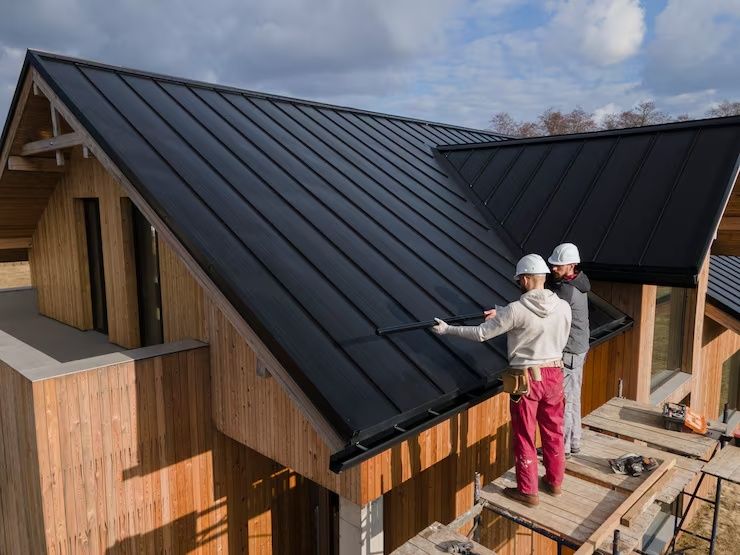Roofing materials are essential components of a building, providing protection from weather, insulation, and structural integrity. Over the years, roofing technology has evolved from traditional clay tiles and wooden shingles to modern options like metal sheets, asphalt shingles, solar tiles, and synthetic membranes.
Modern roofing materials not only protect the building but also contribute to energy efficiency, aesthetics, and sustainability. Choosing the right roofing material depends on climate, building type, budget, and maintenance requirements.

Importance of roofing materials today
The choice of roofing material impacts safety, comfort, and cost-efficiency:
-
Durability and weather resistance – Modern materials withstand rain, snow, wind, and UV exposure.
-
Energy efficiency – Reflective and insulated roofing reduces heating and cooling costs.
-
Aesthetic appeal – Various colors, textures, and designs enhance building appearance.
-
Sustainability – Eco-friendly materials reduce environmental impact and promote green building certifications.
-
Maintenance and lifespan – Long-lasting materials reduce repair frequency and costs.
Roofing materials play a critical role in residential, commercial, and industrial buildings by ensuring protection, comfort, and longevity.
Recent updates and trends in roofing materials
The past year has seen notable advancements in roofing technology:
-
Cool roofing systems (2023–2024): Reflective coatings and light-colored materials reduce heat absorption in urban areas.
-
Solar-integrated roofs: Solar tiles and panels are increasingly combined with conventional roofing for renewable energy generation.
-
Lightweight materials: Engineered composites and metal shingles reduce structural load while maintaining durability.
-
Green roofs: Incorporating vegetation and insulation improves energy efficiency and stormwater management.
-
Smart roofing materials: Self-cleaning and weather-resistant coatings are becoming popular for commercial and residential buildings.
These innovations highlight the focus on sustainability, energy efficiency, and advanced materials in modern roofing.
Laws and policies affecting roofing materials
Several regulations and standards govern roofing materials for safety, environmental compliance, and energy efficiency:
-
Building codes: Local regulations often specify fire resistance, wind uplift resistance, and structural load capacity.
-
Energy efficiency standards: Programs like LEED, BREEAM, and ASHRAE promote reflective, insulated, or solar-ready roofing.
-
Environmental compliance: Policies encourage recycled content, reduced VOC emissions, and eco-friendly materials.
-
Occupational safety: Installation must comply with safety regulations to prevent accidents and ensure worker protection.
-
Sustainable construction incentives: Some governments provide rebates or incentives for energy-efficient roofing solutions.
Compliance ensures safety, sustainability, and durability for residential and commercial projects.
Tools and resources for learning more
Several resources help homeowners, designers, and engineers make informed roofing decisions:
-
Roofing calculators: Estimate material quantities, costs, and thermal performance.
-
Material guides: Provide details on lifespan, maintenance, insulation, and fire resistance.
-
Design software: CAD and 3D modeling help visualize roof layouts and material placement.
-
Industry publications: Reports and case studies provide insights on trends, innovations, and best practices.
-
Training programs: Offer knowledge on installation techniques, materials selection, and sustainable roofing solutions.
These resources make roofing projects safer, efficient, and more sustainable.
Frequently asked questions
What are the most common modern roofing materials?
Asphalt shingles, metal sheets, clay tiles, concrete tiles, synthetic membranes, and solar tiles are popular choices.
Which roofing materials are eco-friendly?
Metal roofing, recycled shingles, clay tiles, and green roofs are sustainable options.
How long do modern roofing materials last?
Lifespan varies: asphalt shingles (15–30 years), metal roofs (40–70 years), clay and concrete tiles (50–100 years).
Can roofs be energy-efficient?
Yes, reflective coatings, insulated roofing, and solar integration significantly reduce energy consumption.
Is maintenance required for modern roofs?
Yes, periodic inspections, cleaning, and minor repairs ensure longevity and performance.
Conclusion
Roofing materials are critical to building safety, efficiency, and aesthetic appeal. Modern options offer durability, sustainability, and energy efficiency that traditional materials cannot always provide.
Advancements in reflective coatings, solar integration, lightweight composites, and green roofing make modern roofs more versatile, cost-effective, and environmentally responsible. For homeowners, architects, and builders, understanding roofing materials is essential to ensure a durable, attractive, and energy-efficient roof that meets both functional and environmental standards.